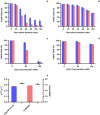Exploring Yeast's Energy Dynamics: The General Stress Response Lowers Maintenance Energy Requirement
- PMID: 40181231
- PMCID: PMC11968331
- DOI: 10.1111/1751-7915.70126
Exploring Yeast's Energy Dynamics: The General Stress Response Lowers Maintenance Energy Requirement
Abstract
In many microbial biotechnology processes, biomass itself is not the product of interest, but rather targeted chemicals or proteins. In these processes, growth should be limited to direct more substrate to product and increase process yields. Under growth-limiting conditions, such as nutrient limitation, microorganisms, including the yeast Saccharomyces cerevisiae, activate a general stress response (GSR). Different hypotheses have been formulated for this activation, including a preparatory role for future stresses or a role in cellular protein density. Here we tested a third hypothesis: the GSR reduces the energy needed to maintain cellular homeostasis, also known as the maintenance energy requirement (MER). The impact of GSR on MER was investigated by assessing the effect of the absence of its key regulators, Msn2 and Msn4, on energy-substrate distribution and stress resistance. Chemostat and fed-batch cultures revealed significant increases in MER of up to 85% in the deletion strain compared to the parental strain. In contrast, maximal biomass yields, growth rates and morphology were unaffected. Our insights highlight an additional role of the GSR, namely saving cellular energy. As the MER is a key determinant of product yields and in process design, especially in low growth processes, our findings can help to optimise microbial bioprocesses.
Keywords: Msn2 and Msn4; energetics; fed‐batch cultures; stress resistance; yeast.
© 2025 The Author(s). Microbial Biotechnology published by John Wiley & Sons Ltd.
Conflict of interest statement
The authors declare no conflicts of interest.
Figures



Similar articles
-
The stress-regulatory transcription factors Msn2 and Msn4 regulate fatty acid oxidation in budding yeast.J Biol Chem. 2017 Nov 10;292(45):18628-18643. doi: 10.1074/jbc.M117.801704. Epub 2017 Sep 18. J Biol Chem. 2017. PMID: 28924051 Free PMC article.
-
Induction of neutral trehalase Nth1 by heat and osmotic stress is controlled by STRE elements and Msn2/Msn4 transcription factors: variations of PKA effect during stress and growth.Mol Microbiol. 2000 Jan;35(2):397-406. doi: 10.1046/j.1365-2958.2000.01706.x. Mol Microbiol. 2000. PMID: 10652100
-
Fine-tuning of the Msn2/4-mediated yeast stress responses as revealed by systematic deletion of Msn2/4 partners.Mol Biol Cell. 2011 Sep;22(17):3127-38. doi: 10.1091/mbc.E10-12-1007. Epub 2011 Jul 14. Mol Biol Cell. 2011. PMID: 21757539 Free PMC article.
-
[Alternative ways of stress regulation in cells of Saccharomyces cerevisiae: transcriptional activators Msn2 and Msn4].Tsitologiia. 2009;51(3):271-8. Tsitologiia. 2009. PMID: 19435282 Review. Russian.
-
Stress response factors drive regrowth of quiescent cells.Curr Genet. 2018 Aug;64(4):807-810. doi: 10.1007/s00294-018-0813-0. Epub 2018 Feb 17. Curr Genet. 2018. PMID: 29455333 Free PMC article. Review.
References
-
- Binai, N. A. , Bisschops M. M. M., Van Breukelen B., et al. 2014. “Proteome Adaptation of Saccharomyces cerevisiae to Severe Calorie Restriction in Retentostat Cultures.” Journal of Proteome Research 13: 3542–3553. - PubMed
-
- Bisschops, M. , Vos T., Martinez‐Moreno R., de la Torre Cortes P., Pronk J., and Daran‐Lapujade P.. 2015. “Oxygen Availability Strongly Affects Chronological Lifespan and Thermotolerance in Batch Cultures of Saccharomyces cerevisiae .” Microbial Cell 2, no. 11: 429–444. 10.15698/mic2015.11.238. - DOI - PMC - PubMed
-
- Bisschops, M. M. M. , Zwartjens P., Keuter S. G. F., Pronk J. T., and Daran‐Lapujade P.. 2014. “To Divide or Not to Divide: A Key Role of Rim15 in Calorie‐Restricted Yeast Cultures.” Biochimica et Biophysica Acta ‐ Molecular Cell Resarch 1843: 1020–1030. - PubMed
MeSH terms
Substances
Grants and funding
LinkOut - more resources
Full Text Sources
Research Materials
Miscellaneous

